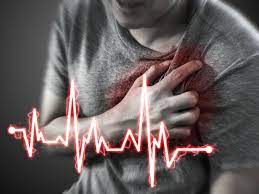Cardiac arrest is the sudden, unexpected loss of heart function where breathing stops and one becomes unconscious. It can lead to death if proper medical intervention is not given. Emergency treatment for cardiac arrest is:
- Cardiopulmonary resuscitation (CPR).
- Use of shocks to the heart by use of an automated external defibrillator (AED).
Symptoms
- No breathing.
- No pulse.
- Sudden collapsing of a person.
- Chest discomfort/pain.
- General body weakness.
- Loss of consciousness.
- Heart palpitation.
Causes of Cardiac arrest
Cardiac arrest occurs due to a change in heartbeat (arrhythmias). An electric signal in the heart controls the rate and rhythm of the heartbeat. Faulty or extra electrical signals may make the heart beat in an uncoordinated manner. Conditions that can lead to sudden cardiac arrest include:
- Ventricular fibrillation. It is an irregular heart rhythm where the lower heart chambers have a slight trembling motion rather than pumping blood.
- Coronary artery disease is where the heart arteries are clogged with cholesterol thus reducing blood flow to the heart.
- Heart attack can leave scar tissue in the heart which leads to a change in the heartbeat.
- Cardiomyopathy. A condition that makes the heart muscles stretch and become bigger.
- Heart valve disease. There is an increased risk of developing a heart rhythm problem when there is a leaking valve from the heart chambers.
- Congenital heart defects. People who have heart problems at birth but are repaired can suffer a cardiac arrest in adulthood.
- Long QT syndrome plus other heart signaling problems e.g. Brugada syndrome.
Risk factors

- Smoking.
- Obesity.
- Diabetes.
- Family history.
- Lack of exercise.
- High blood pressure.
- High cholesterol levels.
- Previous heart attack.
- Use of illegal drugs e.g. cocaine.
- Chronic kidney disease.
- Obstructive sleep apnea is a sleeping disorder.
Prevention of Cardiac arrest
Keeping the heart healthy prevents cardiac arrest. Done by:
- No smoking.
- Regular checks ups.
- Controlling one’s blood pressure plus cholesterol levels.
- Having a balanced diet.
- Heart disease screening.
Diagnosis
- Blood test- to check for a protein that leaks after a damaged heart. To check for the level of potassium, magnesium, body chemicals, and hormones that affect the normal working of the heart.
- Electrocardiogram (ECG or EKG). Checks for the electrical activity of the heart where electrodes are attached to the arms, legs, or chest. Electrodes tell how fast or slow the heart is beating.
- Ejection fraction- test to show the measure of the percentage of blood leaving the heart each time it squeezes.
- Echocardiogram- a test used to show how blood flows throughout the heart and heart valves. Can also show if there is a problem with the heart valves or damaged heart muscles.
- Chest x-ray shows the shape plus size of the heart and lungs.
- Nuclear scar- shows how the blood flows to the heart. A tracer which is a radioactive material is given intravenously. The flow of materials throughout the heart and lungs is observed by the use of a special camera.
- Cardiac catheterization- helps healthcare providers to see the blockage in heart arteries.
Treatment
- Performing CRP which is used to prevent death.
- Use of medication e.g. anti-arrhythmic drugs. Used to treat symptoms and irregular heartbeat.
- Resetting heart rhythm by use of an automated external defibrillator.
- Surgery. Include:
- Coronary angioplasty/percutaneous coronary intervention is where clogged or blocked heart arteries are opened. This improves blood flow to the heart.
- Coronary artery bypass surgery- a new pathway is created for blood to flow due to a blocked artery to the heart.
- Corrective heart surgery. Done to correct heart defect at birth.
- Radiofrequency catheter ablation. It’s used to create a scar in the heart so as to block a faulty heart signaling pathway.
- Implantable cardioverter defibrillator– monitors the heart rhythm. In cases of an irregular heartbeat, it sends out shocks thus resetting the heart rhythm.
- Best Public High Schools in Kiambu County.
- Public Universities in Kenya
- List of Accredited Private Universities in Kenya
- The best private primary schools in Nyeri county.
- Kenya Institute of special education, courses.
- Mount Kenya University history, fees, courses
- How is The Lenana Boy school and location?